Latin name
Atractoscion nobilis (also Cynoscion nobilis)
Other names
Catalina salmon, white corvina, corvina blanca, white weakfish, weakfish, king croaker; French: acoupa blanc; Spanish: corvinata bronzeada.
Identification
The body of white sea bass is elongated and somewhat compressed. Along the middle of the belly, between the abdomen and the base of the pelvic fins, there is a characteristic upbeat ridge. The head is pointed and slightly flattened. The mouth is large, with several small teeth and a protruding lower jaw. The first dorsal fin has nine spines, the second - two spines and 20 soft rays. The anal fin has two spines and 10 soft rays. There are no spines on the chin. Its coloration is bluish-gray on top with dark speckles and becomes silvery underneath. The white sea bass can be distinguished from its Atlantic relatives by the absence of fangs. It is the only California croaker that weighs more than 20 pounds. It is easiest to distinguish from others by the presence of a ridge running the length of its belly.
Distribution
White sea bass are found in the eastern Pacific Ocean, mostly between San Francisco, California, and Baja California, Mexico, as well as in the northern Gulf of California. They are found as far north as southern Alaska and as far south as Chile.
Habitat
Preferring deep, rocky places, white sea bass usually stays near kelp beds at depths of 12 to 25 fathoms. At times, they can be found in shallow surf or deeper waters. Juveniles live in shallow coastal areas, bays, and estuaries.
Size
The average weight of a 28-inch fish is 71⁄2 pounds. The record weight for all tackle is 83 pounds 3 ounces. White sea bass usually lives 5 years.
Life history and Behavior
Spawning occurs in the spring and summer. White sea bass are schooling fish and are present in California waters throughout the year. It is most often found in spring, and in winter, when they converge to spawn squid.
Food and feeding habits
White sea bass feed on anchovies, pilchards, herring and other fish, as well as crustaceans and squid.
Reproduction
No information
| Classification | |
| Phylum | Chordata |
| Class | Actinopterygii |
| Squad | Acanthuriformes |
| Family | Sciaenidae |
| Genus | Atractoscion |
| Species | A. nobilis |
| Features | |
| Conservation status | Least Concern |
| Habitat | Pelagic |
| Life span, years | 20 |
| Maximum body weight, kg | 41 |
| Maximum length, cm | 166 |
| Sailing speed, m/s | No information |
| Threat to people | Edible |
| Way of eating | Predator |


